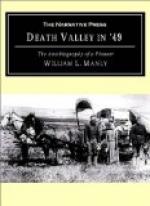Neither of us felt very gleeful as we got our breakfast and made an early start down the river again. Neither of us talked very much, and no doubt my companion had similar thoughts to mine, and wondered what was before us. But I think that as a pair we were at that moment pretty lonesome. Henry had rested better than I but probably felt no less keenly the separation from our homes and friends. We saw plenty of squirrels and pigeons on the trees which overhung the river, and we shot and picked up as many as we thought we could use for food. When we fired our guns the echoes rolled up and down the river for miles making the feeling of loneliness still more keen, as the sound died faintly away. We floated along generally very quietly. We could see the fish dart under our boat from their feeding places along the bank, and now and then some tall crane would spread his broad wings to get out of our way.
We saw no houses for several days, and seldom went on shore. The forest was all hard wood, such as oak, ash, walnut, maple, elm and beech. Farther down we occasionally passed the house of some pioneer hunter or trapper, with a small patch cleared. At one of these a big green boy came down to the bank to see who we were. We said “How d’you do,” to him, and, getting no response, Henry asked him how far is was to Michigan, at which a look of supreme disgust came over his features as he replied—“’Taint no far at all.”
The stream grew wider as we advanced along its downward course, for smaller streams came pouring in to swell its tide. The banks were still covered with heavy timber, and in some places with quite thick undergrowth. One day we saw a black bear in the river washing himself, but he went ashore before we were near enough to get a sure shot at him. Many deer tracks were seen along the shore, but as we saw very few of the animals themselves, they were probably night visitors.
One day we overtook some canoes containing Indians, men, women and children. They were poling their craft around in all directions spearing fish. They caught many large mullet and then went on shore and made camp, and the red ladies began scaling the fish. As soon as their lords and masters had unloaded the canoes, a party started out with four of the boats, two men in a boat, to try their luck again. They ranged all abreast, and moved slowly down the stream in the still deep water, continually beating the surface with their spear handles, till they came to a place so shallow that they could see the bottom easily, when they suddenly turned the canoes head up stream, and while one held the craft steady by sticking his spear handle down on the bottom, the other stood erect, with a foot on either gunwale so he could see whatever came down on either side. Soon the big fish would try to pass, but Mr. Indian had too sharp an eye to let him escape unobserved, and when he came within his reach he would turn his spear and throw it like a dart, seldom missing his




